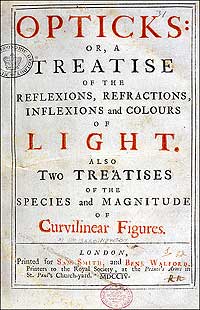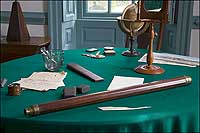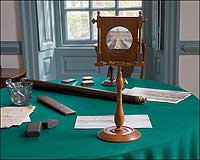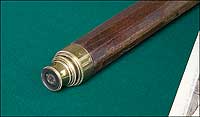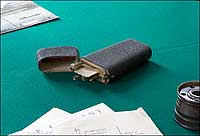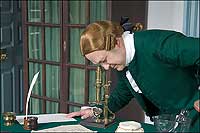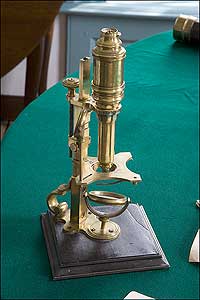Page content
Seeing the Light
A Close Look at Eighteenth-Century Optics
by James Breig
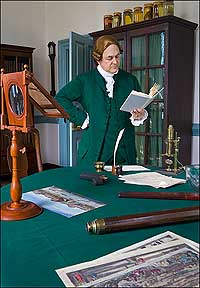
Interpreter Merrit Capossela with a period imaging lens, an antique telescope, and an old microscope. Vision and optics were favored interests in the eighteenth century.
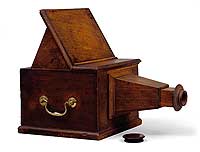
Thomas Jefferson's camera obscura, which projected an image through a lens. (Dave Doody, Thomas Jefferson Foundation)
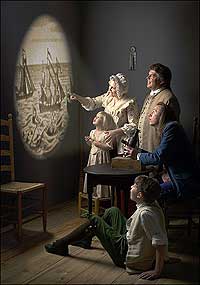
The magic lantern projected images of delight and enlightenment for well-to-do amateurs, here, Willie Balderson at the lantern, with Laura Barry and daughter Elizabeth, Russ Parkhurst next to them, and Ian MacDougall on the floor. (Science and Society Picture Library, Tom Green)
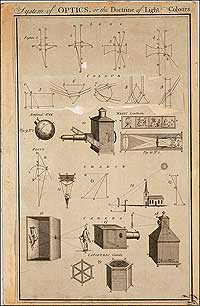
An eighteenth-century English print of the workings of a camera obscura, magic lantern, and other objects of optical interest.
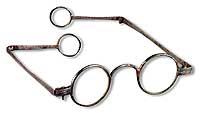
American spectacles with hinged arms in the Colonial Williamsburg collections. (Science and Society Picture Library, Colonial Williamsburg)
Toward the end of the seventeenth century, a Jesuit missionary in China delighted Emperor Cang Hi with what seemed like a toy but proved to be an astonishing scientific instrument. Carved from wood, the object was a semicylinder that had a convex glass in it. When the cylinder was aimed in just the right way, the lens projected images onto the wood. About 100 years later, in a 1785 letter to Thomas Jefferson, Reverend James Madison, president of the College of William and Mary in Williamsburg, wrote: "The Discovery of the Abbe Rochon in optics affords altogether a new field for speculation in that science. It is an Effect wch. I believe no optician before conceived could be produced by one Lens."
From an emperor in Asia to a Virginia academic, the curious men of the Enlightenment wondered about everything they saw—from the blood coursing in their veins to the circling planets overhead. And everything they saw embraced the act of seeing itself and the means by which sight operated: light. If they could comprehend light and sight, scientists reasoned they would be able to look deep within the world around them—and far beyond it. That comprehension would lead to the optical marvels of our times: television cameras that can be swallowed to explore inner space, the orbiting Hubble telescope to explore the deepest reaches of space, and contact lenses.
To get from handheld toys in China to intergalactic starscopes, however, some simply phrased, but complex, questions had to be answered: How do humans see? Of what is light made? Do objects emit particles of light that reach our eyes, or do our eyes send out particles that rebound off objects? Is light made up of such particles, or is it composed of waves that roll on and on like an ocean? What explains how glass can enlarge an image, how an image can be projected with light, or why a telescope's lens distorts what it sees?
The best minds puzzled over those questions for hundreds of years. The 1700s were a pivotal point in the timeline of inquiry. Perhaps the greatest unraveler of optical questions was Isaac Newton, who put the "light" in Enlightenment. He scored a breakthrough when he passed light through a prism to show that it was made of colors. In 1704, Newton published Opticks: Or, A Treatise of the Reflexions, Refractions, Inflexions and Colours of Light, the product of years of experiments on everything from mirrors to soap bubbles. Alexander Pope saluted the scientist with this couplet:
Nature and Nature's laws
lay hid in night:
God said, "Let Newton be!"
And all was light.
Many others, professional and amateur, explored light. Antonie van Leeuwenhoek, a haberdasher in Holland, experimented with lens grinding and microscopes. James Bradley, who succeeded Edmund Halley as astronomer royal, was an Anglican vicar who proved that the earth was not stationary by observing starlight through a telescope. Leonhard Euler, a one-eyed, Swiss-born scientist who lived in Russia, corrected one of Newton's theories. Similarly, a British medical student named Thomas Young showed that light seemed to made of waves. A Quaker in Britain named Samuel Galton fiddled around with Newton's prism, reversed the great man's thinking and came up with a formula to spin the colors on a wheel in just-so proportions to blend them into white.
Eighteenth-century studies in optics make up a catalogue of scientific advances: Halley used a telescope to predict the path of his comet; peering through lenses, William Herschel discovered Uranus; and although unknown to each other, John Hadley of England and Thomas Godfrey of Philadelphia simultaneously invented the octant-sextant in 1731. Previously, navigators employed unsatisfactory instruments to make their way out to sea and back again. Astrolabes, quadrants, cross-staffs, and back-staffs were serviceable, but cumbersome and iffy when it came to accuracy. With mirrors and telescopes, the sextants and octants—the names depended on whether they encompassed a sixth- or eighth-part of a circle—joined with the perfection of longitude clocks to take ships on accurate voyages around the world.
The appeal of optics reached into the homes of everyday, albeit wealthy citizens. Wendy Bellion, assistant professor in the department of art history at Rutgers University, says the interest was "part of the broader Enlightenment. It often had a public aspect to it for the amusement of the middling class." In 1774 in the Pennsylvania Gazette, for example, a shopkeeper named Andrew Porter catalogued "a most curious, elegant and best finished portable optical apparatus, consisting of a brass scioptric ball and socket, a best solar microscope, a Wilsoncompleat, a compound microscope, a best triple object glass perspective ...and a solar telescope." He had also imported an orrery, sextants, and magnifying glasses.
Porter's stock of telescopes testifies to the centuries-long fascination people had in being able to see distant objects, a interest fulfilled in 1608 when Hans Lippershey, a German working in Holland as an optician, invented the telescope—or at least became the first person to record his invention. Within two years, Galileo would announce the conclusions from his celestial observations. Improvements in telescopes would follow from the likes of Keppler and Newton, and they kept coming in the eighteenth century.
Chester More Hall, a British lawyer, tackled a problem derived from the natural effect of glass on light in optical instruments. As light passed through the lens of a telescope, the colors could be distorted and images blurred. Hall found the right combination of glass to fix it. John Dolland, a Huguenot working in London, patented a similar lens—many scholars say he stole the idea from Hall—and made a fortune. One of his telescopes, owned by Jefferson, stands in Monticello.
In France, Alexis Marie Rochon, the abbé who intrigued Jefferson and Reverend Madison, improved the clarity of telescopic images through lens innovations, too. Jefferson described one in 1786: "An Abbe Rochon has applied the metal called platina to the telescope instead of the mixed metal of which the specula were formerly composed. It is insusceptible of rust, as gold is, and he thinks its reflective power equal to that of the mixed metal."
Telescopes evolved for the next 250 years, reaching the sophistication of the space-based Hubble that allows humans to see back in time by seeing far into the cosmos. The Hubble has brought scientists to what one called "the end of the beginning," meaning to the edge of seeing when the universe was born.
If lenses let people peek into worlds beyond, it was reasonable to suspect lenses could peer into tinier worlds. Hans Jansen, another Dutch optician, is credited with inventing the twin-lens microscope in 1595. Robert Hooke, an Englishman, and Christaan Huygens of Holland came up with the triple-lens microscope with two eyepieces in the seventeenth century. Van Leeuwenhoek from Delft, who lived into the first quarter of the eighteenth century, designed a microscope with a magnification power of 300.
Microscopes were part of an educated man's study in the 1700s. John Adams said that "the Telescope has settled the Regions of Heaven, and the Microscope has brought up to View innumerable millions of Animals that Escape the observation of our naked sight." But James Logan, a Philadelphia merchant and amateur scientist, said that while microscopes allowed humans to see invisible worlds, there were probably still tinier things that would never be viewed, given the limits of man's senses.
Here were discoveries and inventions in optics beyond the realm of hard science. "There were a number of optical toys to produce optical illusions," said Professor Bellion, who had a fellowship at the Omohundro Institute of Early American History and Culture in Williamsburg. "There were new kinds of optical techniques, and older forms were popular as well, such as the camera obscura, a predecessor to the modern photographic camera. There was also the Claude glass, a concave mirror you held up to see what was behind you."
Magic lanterns were among the toys. References as early as 1420 talk about a device that projected an image onto a wall or screen by throwing light through an illustrated slide. As the centuries unfolded, scientists like Huygens learned to focus and enlarge the images. On August 19, 1666, Samuel Pepys, who had an interest in "opticke enquiries," recorded in his diary that he saw at a friend's house "a lanthorne with pictures in glasse, to make strange things appear on a wall, very pretty."
Magic lanterns were often used to frighten audiences, with images of the devil, for example, and "various Apparitions and Disappearances," as a 1668 description put it. In the eighteenth century, such demonstrations became known in some places as "Phantasmagoria" and treated the audience to such sights as ghostly apparitions, eery monstrosities, and "the bleeding nun." Etienne Gaspard Robertson put his magic lantern—which he called a Fantascope—on wheels so that he could shift the size of the image by moving the projector to and fro.
Travelogues were popular as well, such as one presented in Philadelphia in 1749. An advertisement in the Pennsylvania Gazette said that audiences "imagine themselves present in the respective places, and find it the safest, cheapest, and most delightful way of travelling that was ever invented." Among slides projected by "the famous Philosophical Optical Machines" were scenes of London, including the Thames, St. James's Palace, and Lambeth, "with the archbishop of Canterbury's palace."
The camera obscura was put to uses ranging from painting to entertainment. It was based on a simple principle known for centuries: When light shines through a small aperture into a dark room, it casts an upside-down image of what's outside on the interior wall opposite the opening. In Latin, camera obscura means "dark chamber." Ancient Chinese philosophers and Aristotle noted the phenomenon, and scientists toyed with it for centuries. But when lenses were placed over the apertures in the sixteenth century, the image could be enlarged and focused, making it particularly useful for drawing. Giambattista della Porta, an Italian playwright and amateur scientist, said in a 1558 book that by using a camera obscura, "you will see almost an epitome of the world. These things ...will make you marvel to no small degree."
An 1805 letter to Jefferson indicates that he owned at least two. William Tatham, a friend in London, ordered a new one for the president "to be made as elegantly plain as possible, by the best workmen with spare glasses of several focuses, Diagonal Head, &c, compleat." A camera obscura could be as small as a tabletop device or as large as a living room. Jefferson's camera obscura can be seen at www.monticello.org.
A camera obscura went along with Lewis and Clark to help them record plants and animals, and Etienne de Silhouette used one for the portraits that carry his name. Modern painter David Hockney says, to the consternation of some art critics, that the Old Masters turned to the camera obscura and lenses to help them take images from the real world and trace them to re-create perfect perspectives. Artists in the eighteenth century had another tool to achieve that aim, thanks to Britain's Brook Taylor. Professor Christopher Tyler at the Smith-Kettlewell Eye Research Institute in San Francisco, said Taylor was the "artist and mathematician who developed the Taylor Series, which is the foundation for virtually all analysis in physics even today." He said Taylor's perspective insight was a "key advance" in the "full understanding of perspective."
The relative miniaturization of the camera obscura was another advance in the eighteenth century, Tyler said: "It was used by Canaletto and Sir Joshua Reynolds, founding president of the Royal Academy in London. Quite how they used their devices in composing their works remains obscure."
The idea of using lenses to correct vision had been around at least since the Greeks and Romans used magnifiers to improve their sight. Roger Bacon, in the thirteenth century, recommended "crystal or glass or other transparent substance" with a convex curve as a means of correcting weak eyes. He meant that the crystal should be laid on the object to enlarge it, much as a child might discover that a glass paperweight enlarges the Sunday comics. Johannes Kepler was the first to explain how eyeglasses could correct poor vision, thanks to his studies of the cornea and retina.
By the eighteenth century, glasses were an everyday item. Many of the Founding Fathers wore them. A portrait of Patrick Henry shows specs pushed atop his head. After the Revolution, George Washington used his reading glasses to make the poignant point that he had grown old and nearly blind in the service of his country. Jefferson owned a pair of sunglasses, which were the circa-1750 creation of Londoner James Ayscough, who said that clear light was damaging to the eye. It was also during the 1700s that spectacles acquired ear pieces to hold them in place, thanks again to Ayscough.
And someone came up with bifocals. Some credit Benjamin Franklin, but others boost Samuel Pierce as the inventor. Franklin, who called the innovation his "double spectacle," got the idea after becoming annoyed with having to shift between glasses for reading and ones for viewing distant objects. He instructed his optician to combine the lenses into one set of glasses and said, "I have only to move my eyes up or down, as I want to see distinctly far or near, the proper glasses being always ready."
As the eighteenth century closed, Ludwig von Beethoven composed a duet for viola and cello that he and a good friend, Nikolaus Zmeskall, could perform. Aware of Zmeskall's poor vision and his own weakening eyesight, Beethoven titled the work "Duet with Two Eye-Glasses Obbligato," the last word a reference to the musical term for a passage by an accompanying instrument.
The scientific advances and just plain fun of optics in the eighteenth century were summed up by David Rittenhouse, the Pennsylvania polymath, who called light "this wonderful substance, ...which animates all nature in the eyes of man, and perhaps, above all things, disposes him to acknowledge the Creator's bounty."
Brainteasers
The avid curiosity about optics among amateur scientists in the eighteenth century can be seen in the pages of publications like London’s Gentleman’s Magazine. In 1748, it posed “Three Paradoxes in Optics” to its readers:
I. There is an object, which, when view’d by the Microscope, is not at all magnify’d, tho’ you use a Lens of the greatest magnifying power.
II. There is an object, which, when view’d by the Microscope, shall appear less than it does to the naked eye, let the Lens, by which you view it, be of ever so great a magnifying power.
III. There is a 3rd object to be viewed by the Microscope, some parts of which shall appear magnify’d, as other objects, and some other of its parts shall not appear magnify’d at all; and yet the whole object is seen thro’ the microscope at one view.
What’s the answer to this head scratcher? At the end of 1748, “J.C.X.” offered his solution:
Answer to Paradox I. The fine edge of a knife (or fine blade of steel) when truly set, cannot be magnified by the best Lens, by reason of the acuteness of the angle at the edge.
Answer to Paradox II. The same knife, or fine blade sharp-pointed, when held horizontally be- fore the glass, shall appear less than when in a perpendicular position.
Answer to Paradox III. As above, the fine edge cannot be magnified, which is one part of the object; so if the same blade be held oblique to the Lens, the superficial part of the blade will be magnified, when the other part (the edge) is not, yet the whole seen thro’ the Lens at one view.
It was cutting-edge science from very sharp minds.
James Breig, an Albany, New York, editor and writer, contributed a story about colonial puppets to the spring 2005 journal.
Suggestions for further reading:
- Astronomers and Stargazers from the Winter 2005 Journal.
Web sites offer information about optical history and modern optics.
- At www.hubblesite.org, explore outer space.
- Seach for "optics" at www.historycooperative.org/journals, and read about about eighteenth-century optical oddities.
- At www.lewis-clark.org, search for "camera obscura" to read about its contribution to exploration of the American West.
- How artists employed the camera obscura is explained at www.tigtail.org. Look for "camera obscura."

